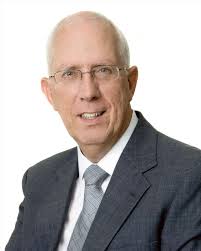
Aurizon CEO Lance Hockeridge needs a new speech writer:
Aurizon chief executive Lance Hockridge has claimed the expansion of a coal export terminal at Queensland’s Abbot Point will be done in an “environmentally sensitive manner” as he reiterated confidence in Asian demand for Australian resources.
“The ‘Chicken Little’ view of resource demand does not recognise the reality of the long term dynamics in China, Indian and other Asian economies,” Mr Hockridge told the Israel Chamber of Commerce in Brisbane on Wednesday.
“Despite the emergence of renewables, coal will remain the most cost-effective source of energy for decades to come and will play a major role in lifting living standards in developing countries by addressing the critical issues of ‘energy poverty.’”
…“Our company, I would content, like our nation is at an important inflection point. Without ambition and some ‘out of the box thinking’, we’d be consigning ourselves to limited growth and limited value-add for customers and shareholders.”
Just quietly, since when was burning commodity bear straw men and building coal and iron ore infrastructure out of the box thinking? And then there is this from S&P this morning:
As governments globally seek to reduce their CO2 emissions, it looks increasingly likely that “King Coal” will lose its crown, and a significant decline in coal production and consumption globally is becoming a much more realistic scenario, Standard & Poor’s Ratings Services noted in a report published titled Carbon Constraints Cast A Shadow Over
According to Standard & Poor’s credit analyst Elad Jelasko: “The current structural changes in the thermal coal industry are not uniquely linked to climate change regulation, but result from the emergence of alternative cheaper energy in the U.S. As a result, and also due to the ramp-up of new mines globally, the price of thermal coal in the seaborne market has been steadily declining over the past two years–to US$75 per ton at present from US$105 per ton in early 2012–which is putting pressure on a large part of the industry.”
Over the medium term, we expect new environmental policies to emerge, which could slow down the demand for coal. On June 2, 2014, the U.S. Environmental Protection Agency (EPA) announced environmental rules to curb CO2 emissions in the power sector by 30% by 2030 from 2005 levels. Earlier in the year, policymakers in China announced strategic objectives to reduce energy consumption and carbon intensity relative to GDP over the next five years.”The demand for coal in the future and its price will rely on numerous factors and their timing,” said Standard & Poor’s credit analyst Michael Wilkins. “Carbon pricing through either taxation or cap and trade emission reduction schemes is among them. We believe new initiatives, such as those made recently by the U.S. and China, may flatten the growth in coal demand over the coming years.”
That said, we believe that countries globally will find it hard to change their energy profiles materially over the next five-to-10 years without compromising their economic competitiveness. This is mainly because of the cost of coal compared with other energy sources and the lack of alternative energy infrastructure. As a result, we still expect the demand for coal to grow in absolute terms over the next five years, notably in countries such as India and China, albeit at a lower-than-historical rate.
China, which accounts for 45% of global coal consumption, remains a wild card. We believe that the country is heading toward peak demand, which will likely occur toward 2020, after an increase of 7.5% per year in the last eight years. Any decision that China makes would have implications for coal miners across the border.
The U.S. coal market has undergone a dramatic shift, following the discovery of large deposits of natural gas in early 2010. In our view, a complete replacement of coal with shale gas looks unrealistic over the short-to-medium term. We believe coal in the U.S. will continue to remain an important, albeit declining, energy source.
“It is clear that already in today’s market, the economics of exporting U.S. coal do not add up. Investors need to understand where we will see this kind of structural change in the coal market next,” said James Leaton, Research Director at Carbon Tracker Initiative.
We also believe that large energy deficits persist in key countries in Asia (India, Vietnam, and Indonesia for example), where pollution is either not top of the agenda or an issue, and electricity growth through coal will continue to encourage production growth. Those countries can support coal, while other countries move to more friendly energy sources.
Adeline Diab, Head of Responsible Investment Integration at Aviva Investors, said: “Many catalysts are changing the landscape of the coal industry, including substitution to gas and renewable energy while peak demand is reached or efficiency programs are being launched in most countries. As the world is embarking on its transition to a low carbon economy, actions are being taken to address pollution, and tightening carbon constraints are implemented in key markets. This means the dynamics and change of the coal market is accelerating. However, markets are currently only selectively pricing these risks even though they are material to long-term capex plans and current market values. This report provides key insight as it explores scenarios to understand how these shifts break with historic trends and will impact portfolios.”
Aurizon’s West Pilbara play and coal cheer-leading don’t fill me with confidence in this firm.

